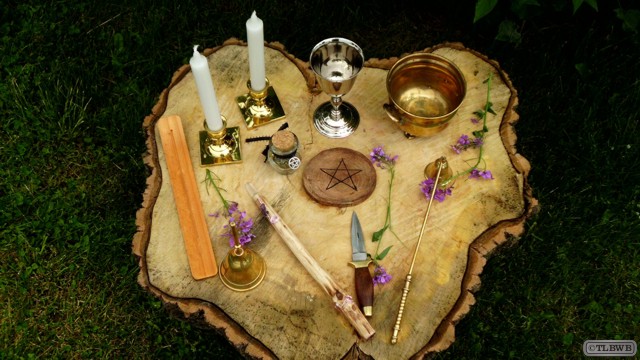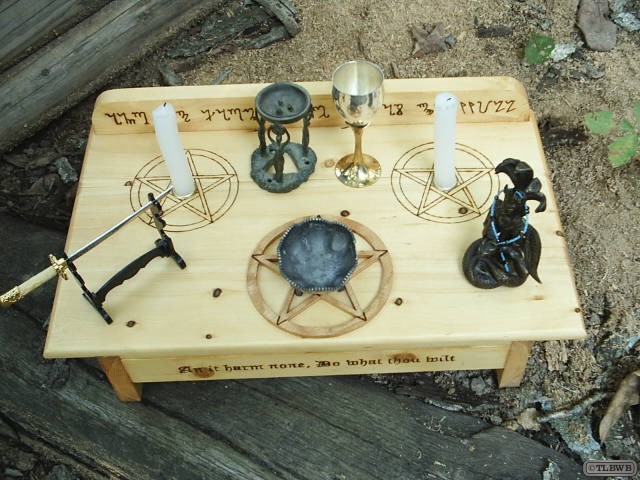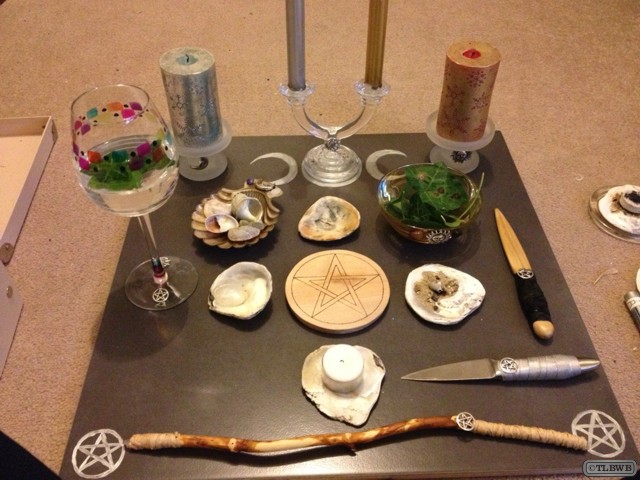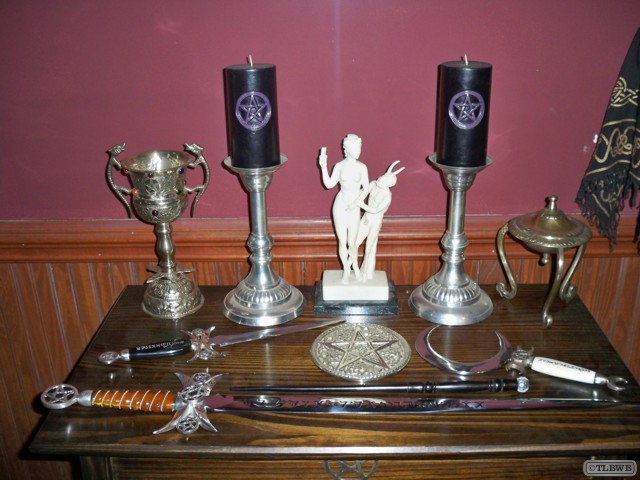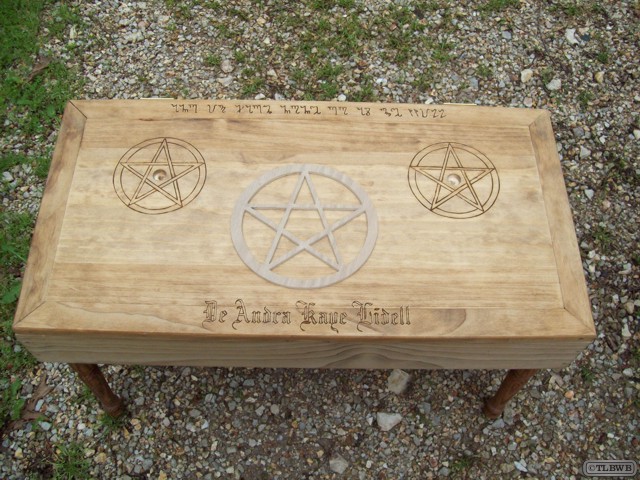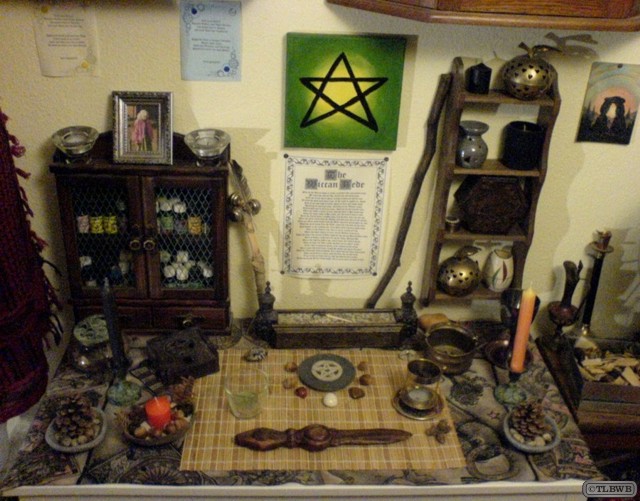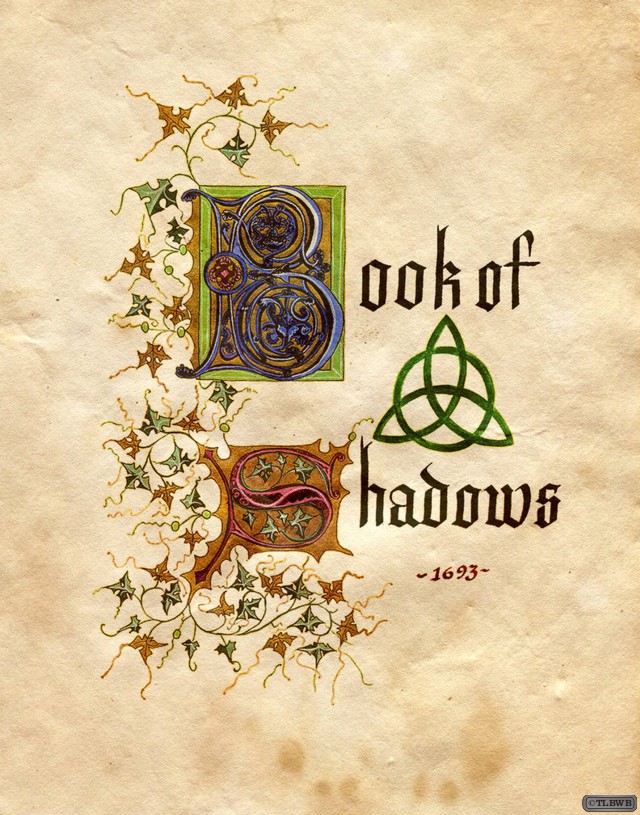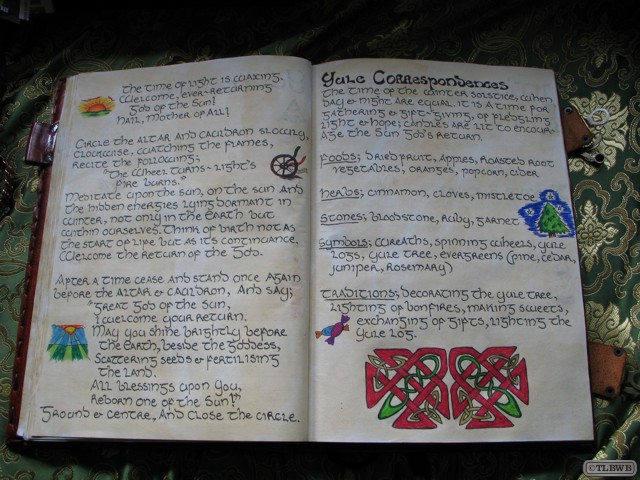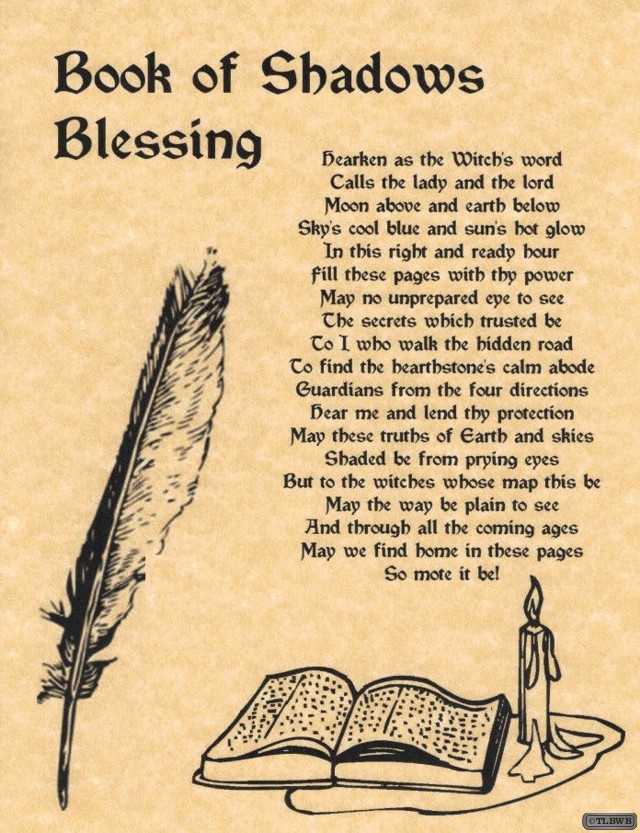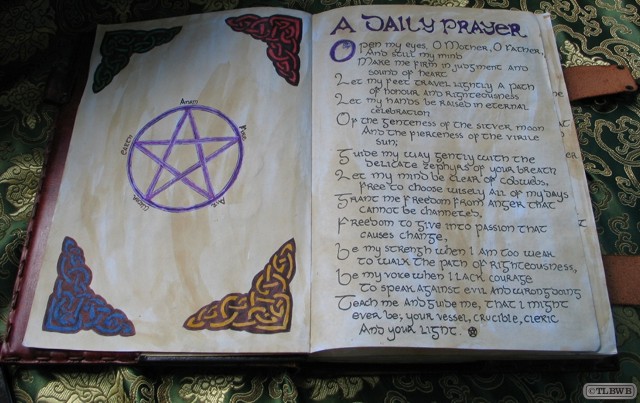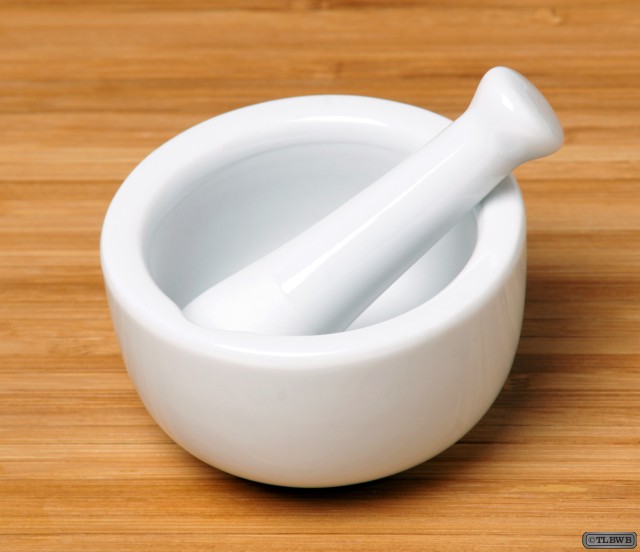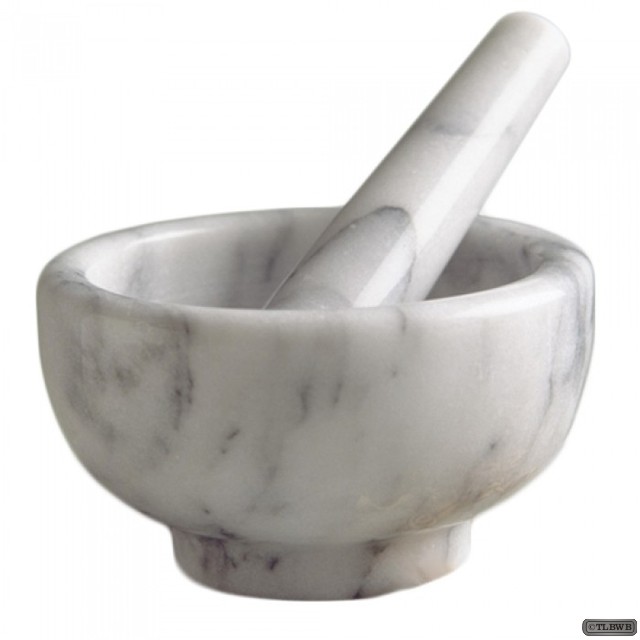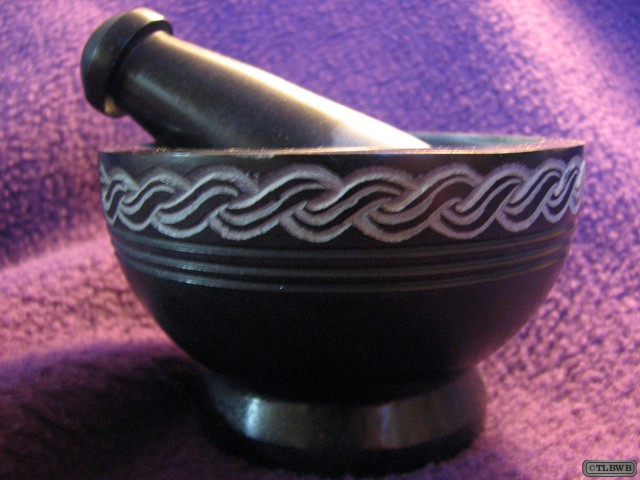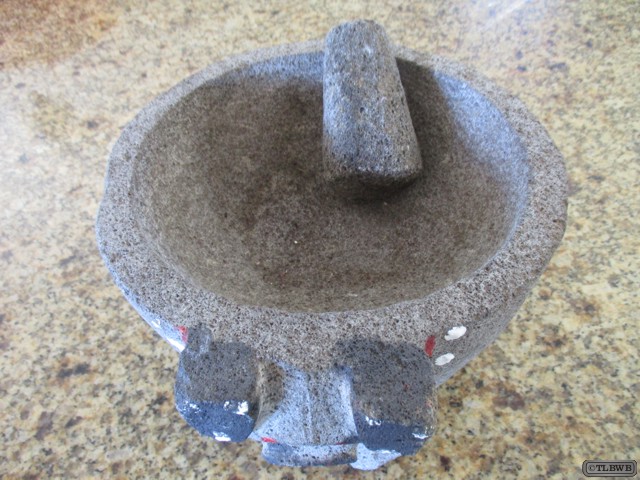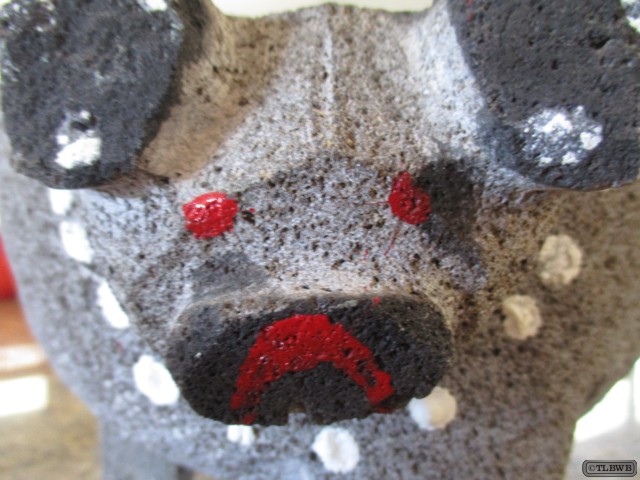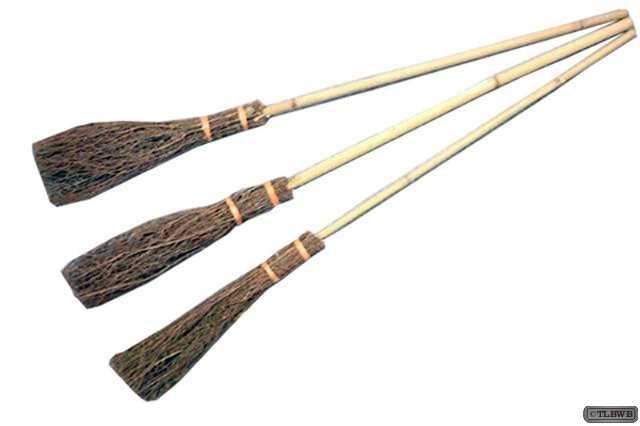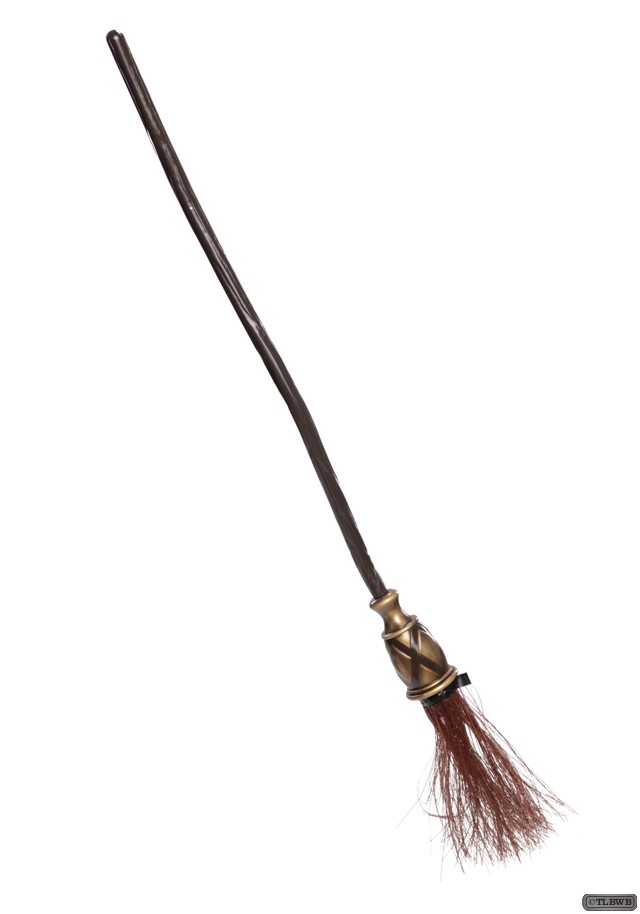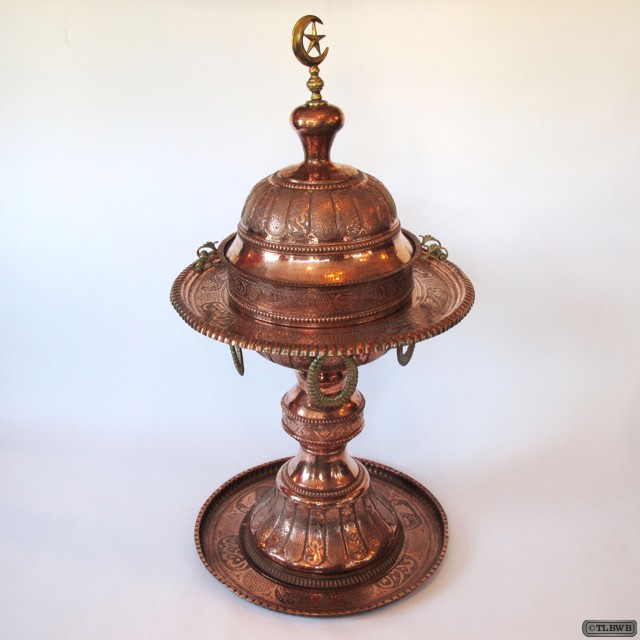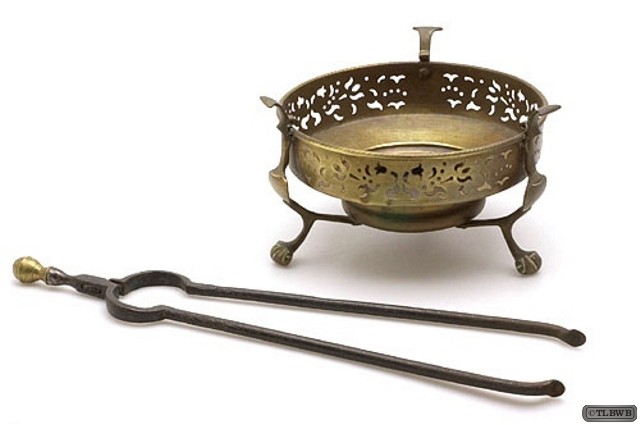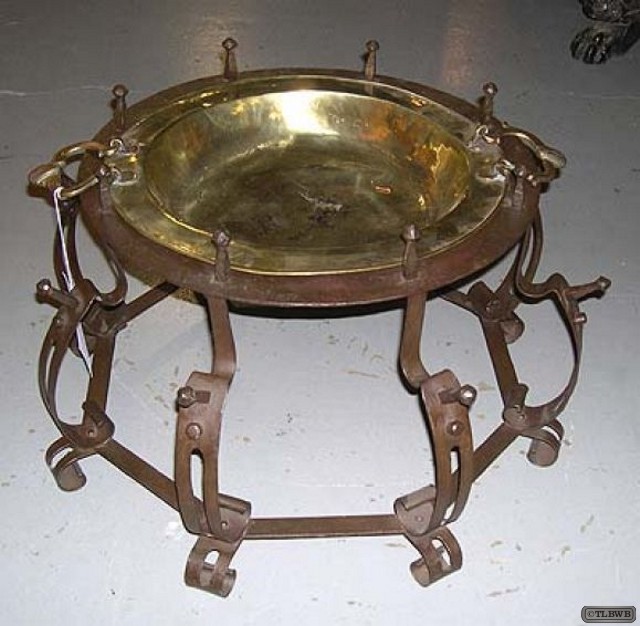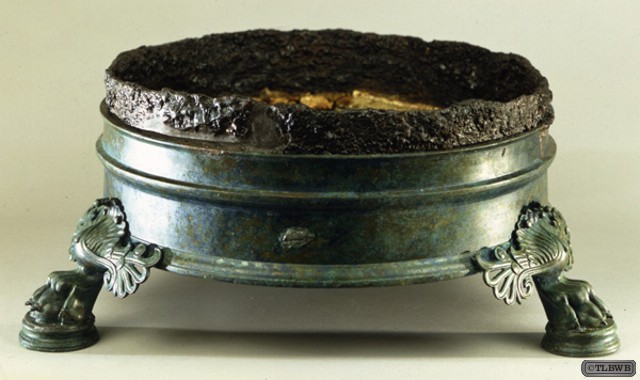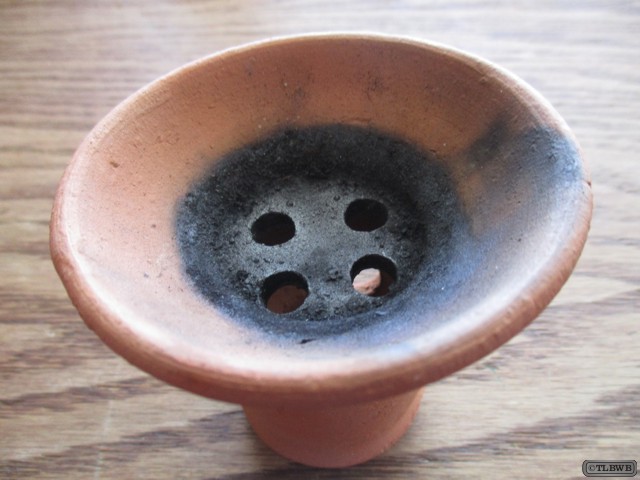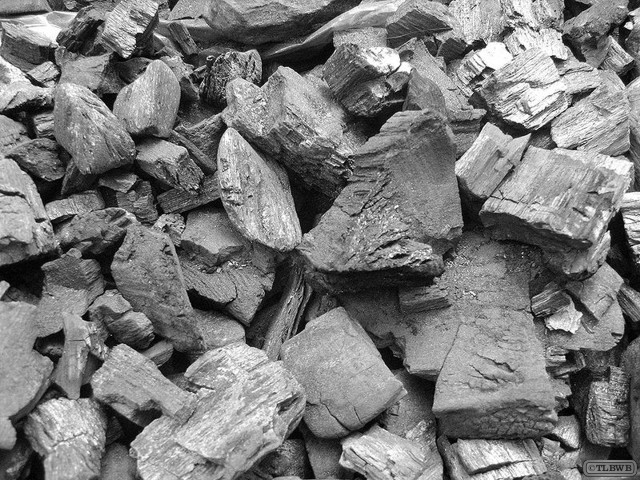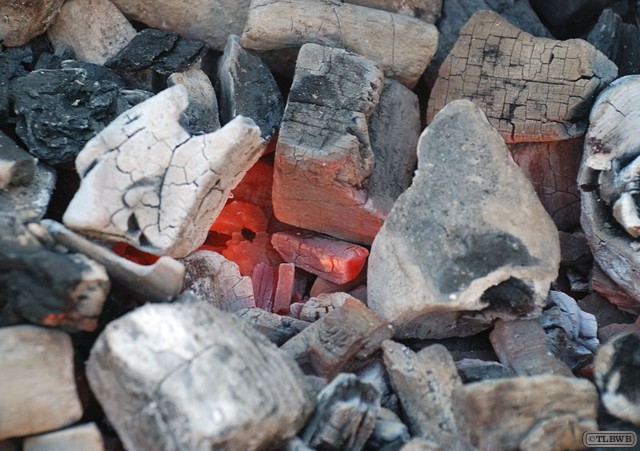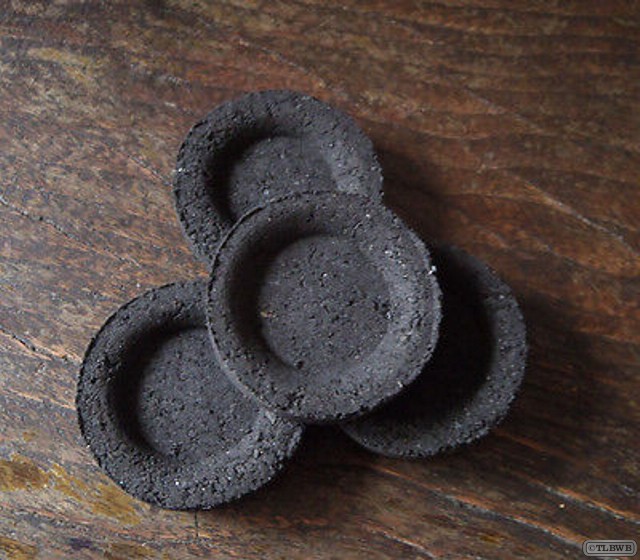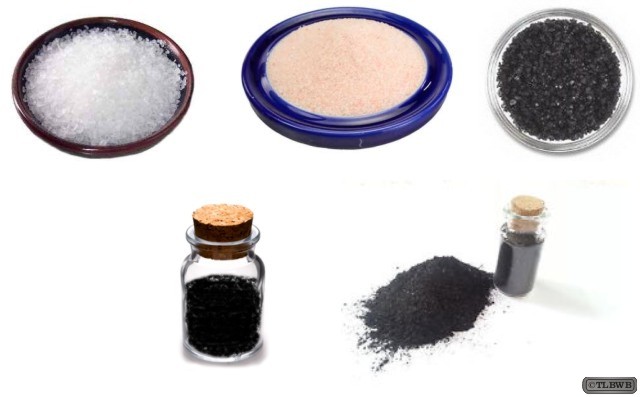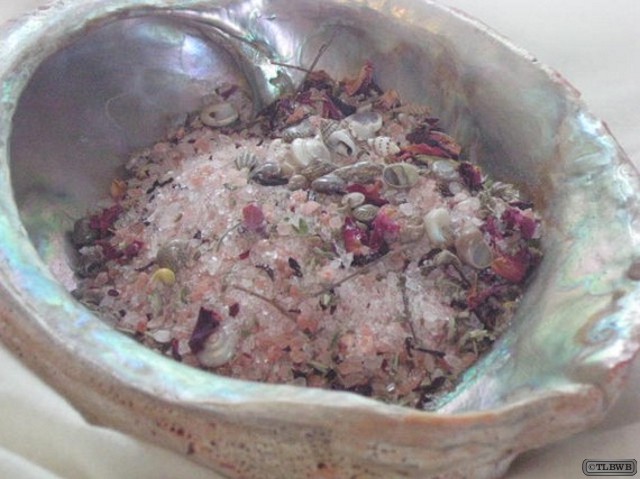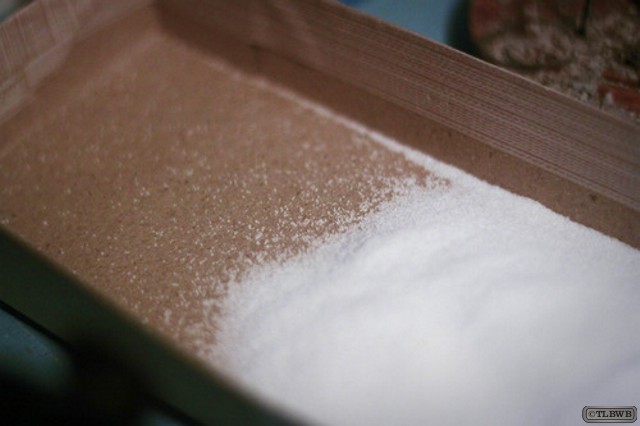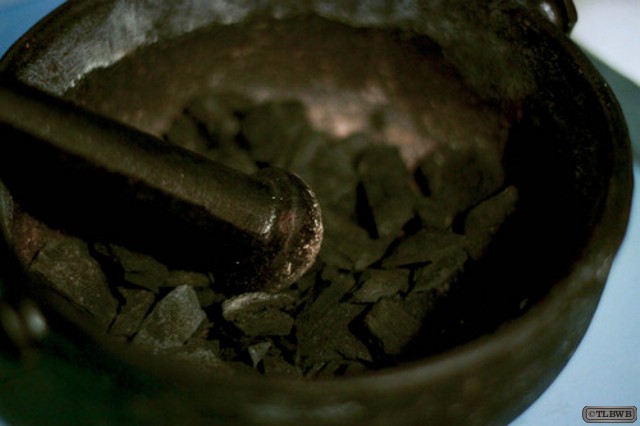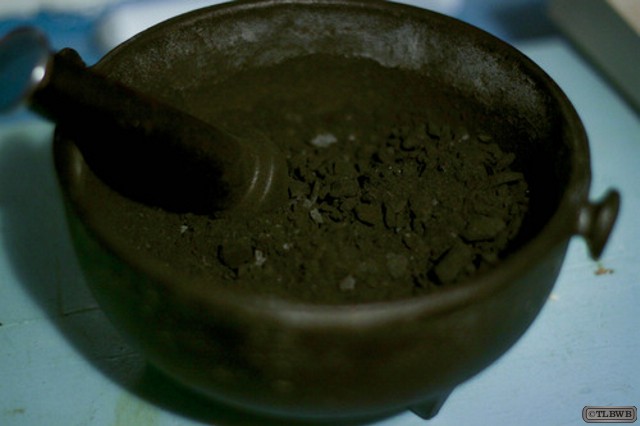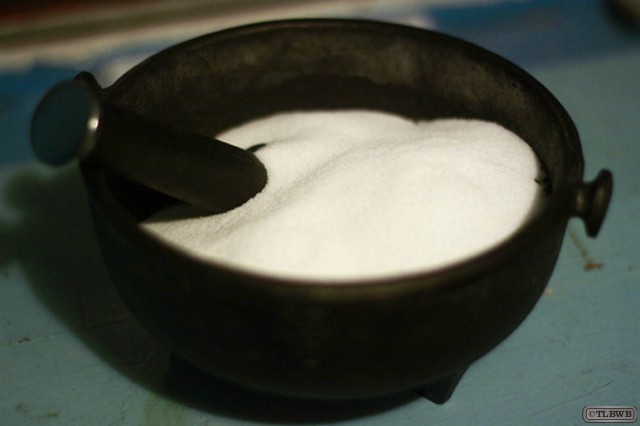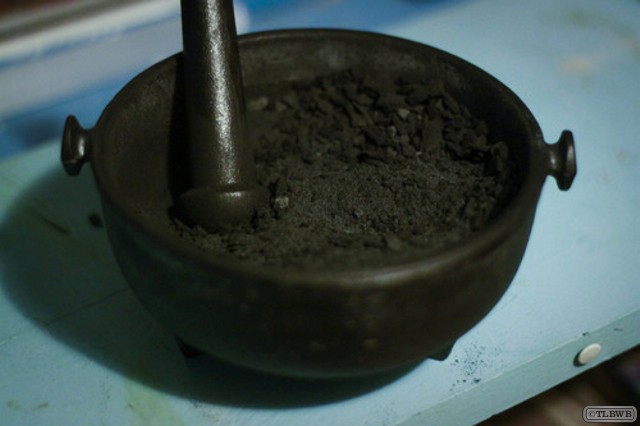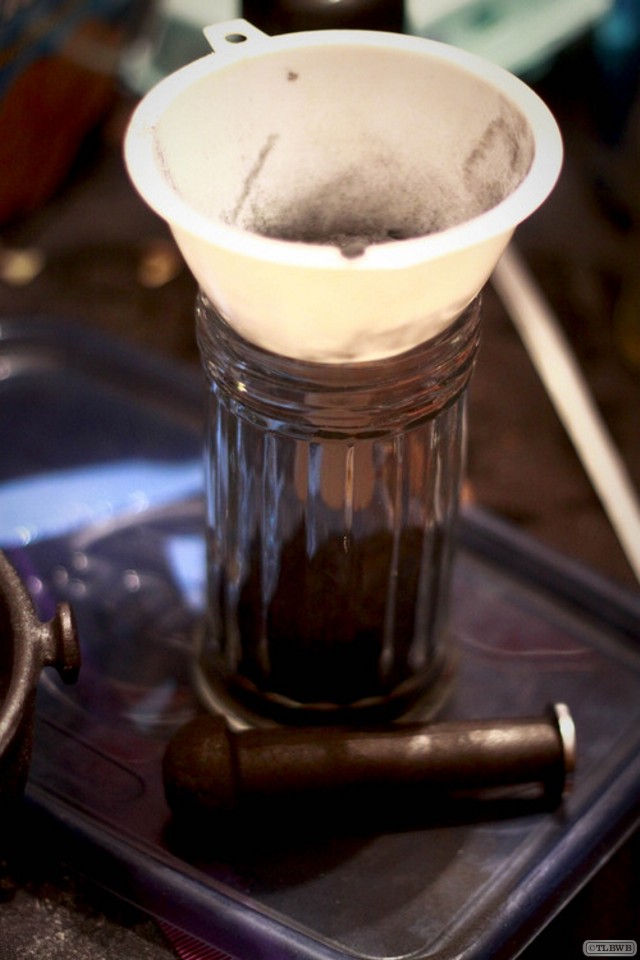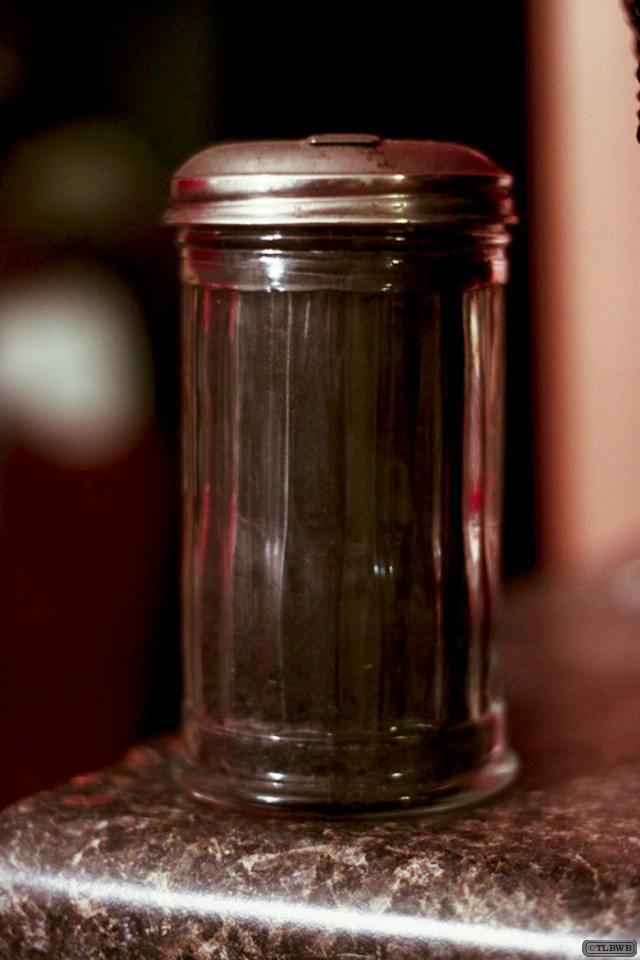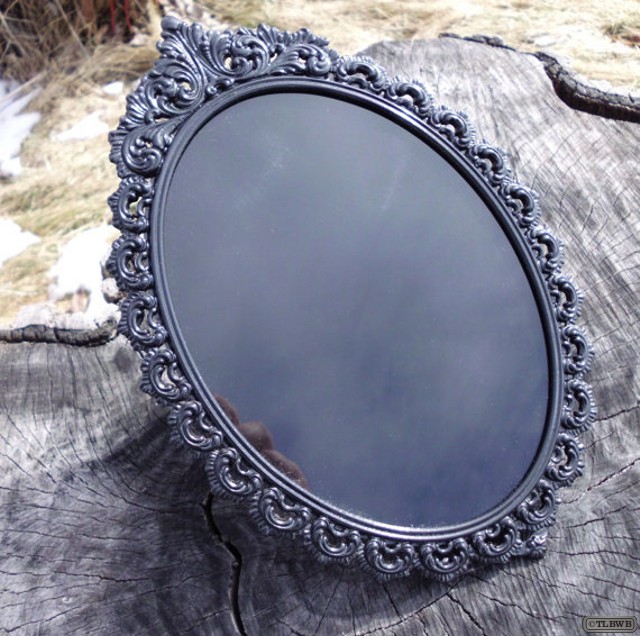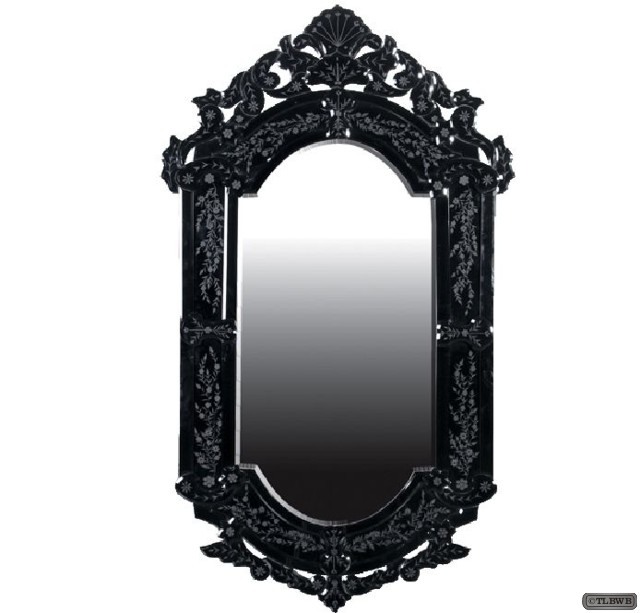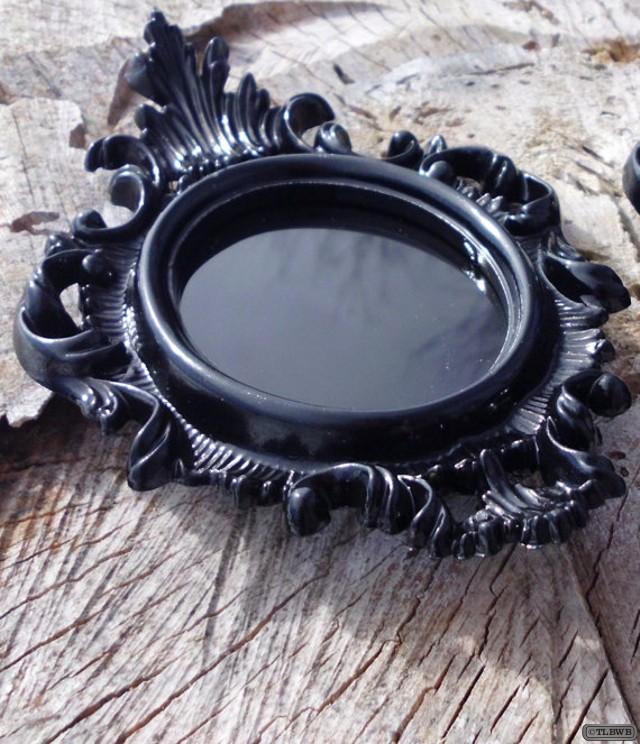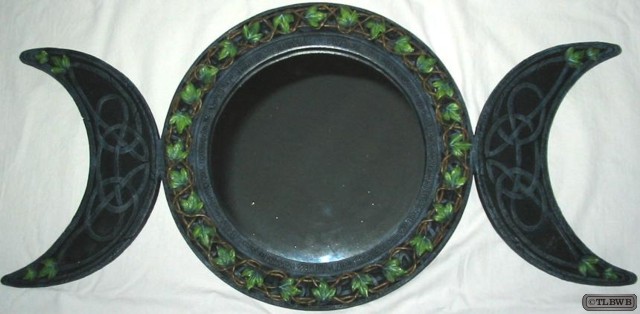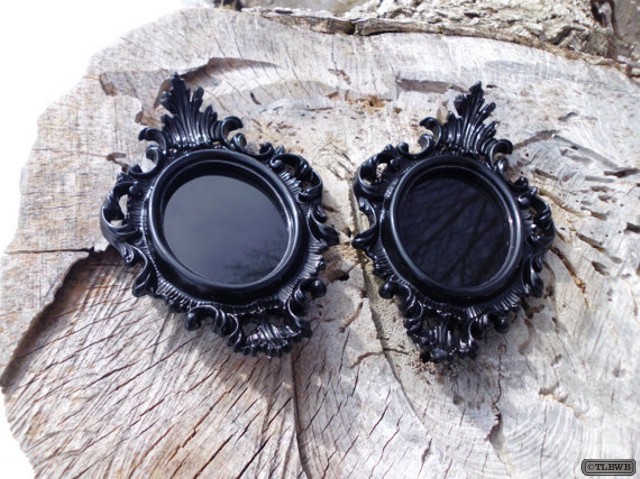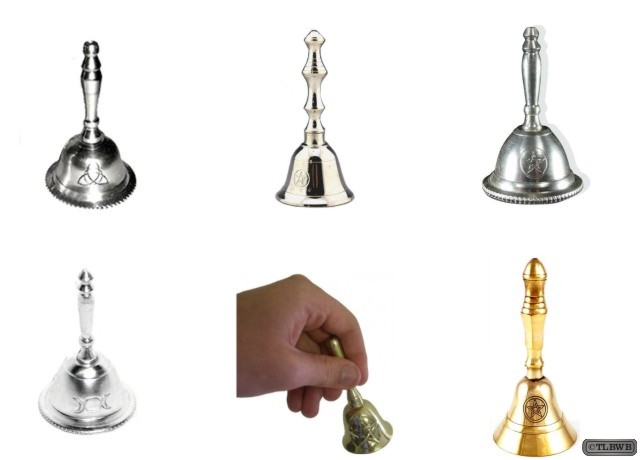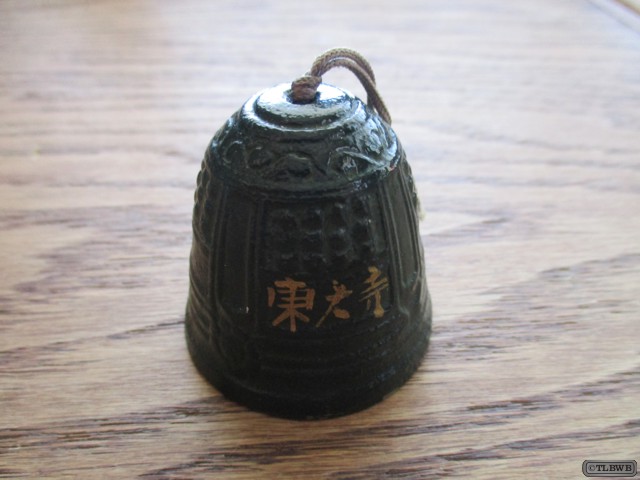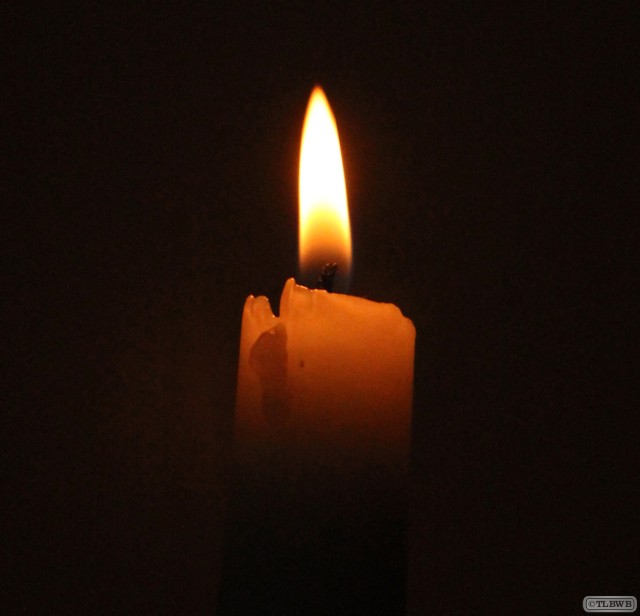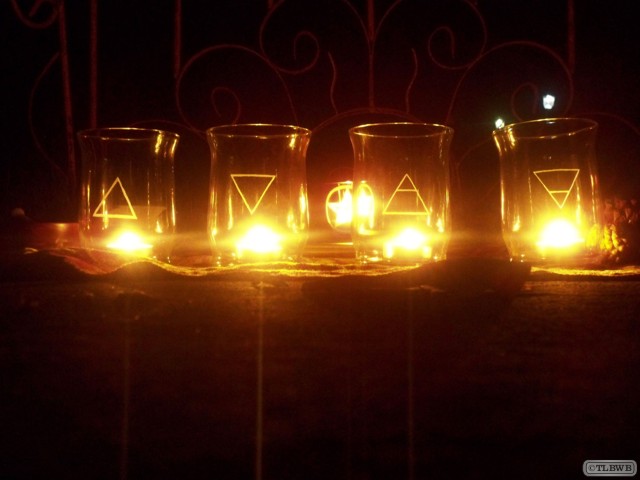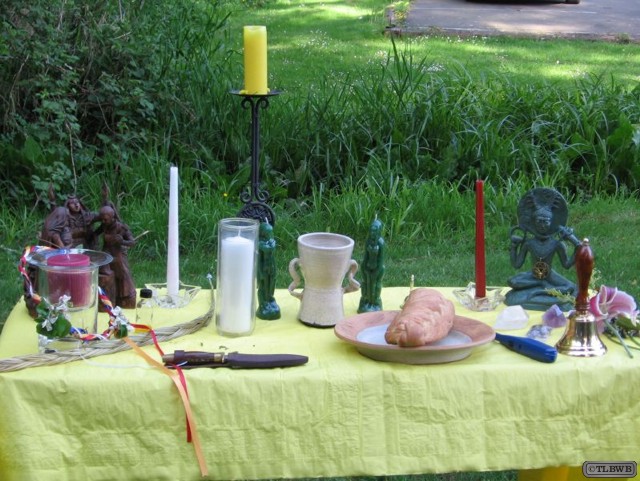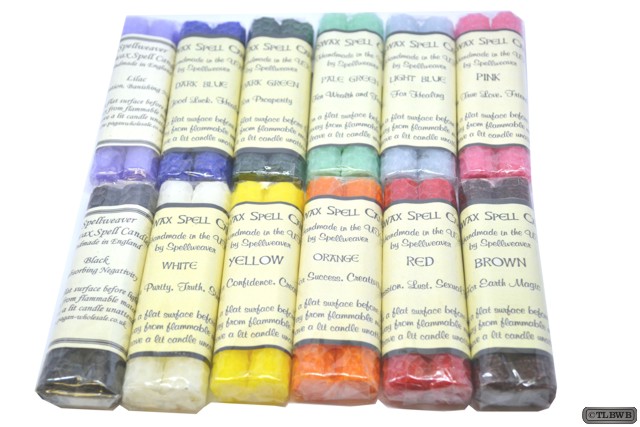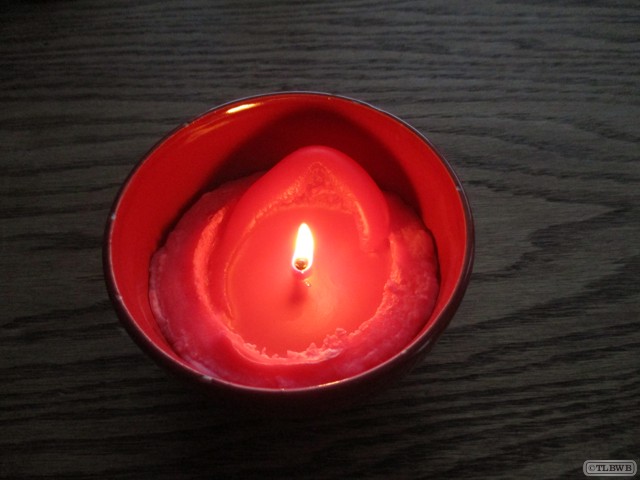Magical Tools
Magical Tools
A Wiccan altar is a “raised structure or place used for sacrifice, worship, or prayer”, upon which a Wiccan practitioner places several symbolic and functional items for the purpose of worshiping the God and Goddess, casting spells, and/or saying chants and prayers.
Altar Items
The altar is often considered a personal place where practitioners put their ritual items. Some practitioners may keep various religious items upon the altar, or they may use the altar and the items during their religious workings. According to Scott Cunningham, a popular Wiccan author, the left side of the altar should be considered the Goddess area; feminine or yonic symbols such as bowls and chalices, as well as Goddess representations and statues should be placed on the left. The right side is designated for the God; phallic symbols such as the athame and the wand are placed to the right side, as well as God statuary and his candle. The left and right associations vary according to personal preference, but the center area is almost always considered the “both” area, or the working area. In the center of the altar are kept the main symbols of the Wiccan faith, such as the pentacle.
Some Wiccans arrange their altars to represent all four elements and directions. In the North the earth element is represented; in the east is air, in the south is fire, and in the west water. These elements can be represented in various ways, but generally do not vary in elemental and directional correspondences. When placing items on an altar or when “calling on the elements” (a practice involving inviting the elements to be a part of the circle and lend their power) a practitioner will move deosil (clockwise or sunwise) and when dismissing the elements they will move widdershins (counter-clockwise).
Some of the items represent the Earth’s four elements, but elements may be represented more literally, with gems, salt, water, plant material, insect casings, etc.
Opening Of Circle
Walking clockwise from East.
By the air that is her breath
By the fire that is her bright spirit
By the living waters of her womb
And by the earth that is her body
The circle is cast,
Tie the knot of the circle
So Mote It Be!
Open The Circle
First cut the knot.
Walking counterclockwise from East.
By the air that is her breath
By the earth that is her body
By the living waters of her womb
And by the fire that is her bright spirit
The circle is open but not unbroken.
May the joy of the Goddess live in our hearts
Merry Meet,
Merry Part,
And Merry Meet Again!
The Lost Bearded White Brother
Despite popular movies and television shows, there is no one single book of shadows. A book of shadows, or BOS, is a Wiccan or Pagan’s notebook of information. It usually contains spells, rituals, correspondence charts, information about the rules of magic, invocations, myths and legends of various pantheons, etc. Sometimes information in a BOS is passed along from one Wiccan to another (and in a coven setting, there may be a coven BOS as well as individual members’ books), but you can create your own with a little bit of effort. A BOS is a very personal thing, and should contain the information you find most important.
How To Make a Book of Shadows
The Book of Shadows (BOS) is used to store information you’ll need in your magical tradition, whatever it may be. Many Pagans and Wiccans feel a BOS should be handwritten, but some use a computer to store information as well. Bear in mind that a BOS is considered a sacred tool, which means it is an item of power that should be consecrated with all of your other magical tools. In many traditions, it is believed you should copy spells and rituals into your BOS by hand – this will not only transfer energy to the writer, but it also helps you to memorize the contents.
Make sure you write legibly enough that you’ll be able to read your notes during a ritual!
To make your Book of Shadows, begin with a blank notebook. A popular method is to use a three-ring binder so items can be added and rearranged as needed. If you use this style of BOS, you can use sheet protectors as well, which is great for preventing candle wax and other ritual drippings from getting on the pages! Whatever you select, your title page should include your name. Make it fancy or simple, depending on your preference, but remember that the BOS is a magical object and should be treated accordingly. Many witches simply write, “The Book of Shadows of [your name]” on the front page.
What format should you use? Some witches are known to create elaborate Books of Shadows in secret, magical alphabets. Unless you’re fluent enough in one of these systems that you can read it without having to check notes or a chart, stick with your native language. While a spell looks beautiful written out in flowing Elvish script or Klingon lettering, the fact is that it’s just hard to read unless you’re an Elf or a Klingon.
When it comes to the contents of your personal BOS, there are a few sections that are nearly universally included.
Laws of your coven or tradition:
- Believe it or not, magic has rules. While they may vary from group to group, it’s a really good idea to keep them at the front of your BOS as a reminder of what constitutes acceptable behavior and what doesn’t. If you’re part of an eclectic tradition that doesn’t have written rules, or if you’re a solitary witch, this is a good place to write down what YOU think are acceptable rules of magic. After all, if you don’t set yourself some guidelines, how will you know when you’ve crossed over them? This may include a variation on the Wiccan Rede, or some similar concept.
A dedication:
- If you’ve been initiated into a coven, you may want to include a copy of your initiation ceremony here. However, many Wiccans dedicate themselves to a God or Goddess long before they become part of a coven. This is a good place to write out who you are dedicating yourself to, and why. This can be a lengthy essay, or it can be as simple as saying, “I, Willow, dedicate myself to the Goddess today, June 21, 2007.”
Gods and Goddesses:
- Depending on what pantheon or tradition you follow, you may have a single God and Goddess, or a number of them. Your BOS is a good place to keep legends and myths and even artwork concerning your Deity. If your practice is an eclectic blend of different spiritual paths, it’s a good idea to include that here.
Correspondence tables:
- When it comes to spellcasting, correspondence tables are some of your most important tools. Phases of the moon, herbs, stones and crystals, colors – all have different meanings and purposes. Keeping a chart of some sort in your BOS guarantees that this information will be at the ready when you really need it. If you have access to a good almanac, it’s not a bad idea to record a years’ worth of moon phases by date in your BOS.
Sabbat rituals:
- The Wheel of the Year includes eight holidays for most Wiccans and Pagans, although some traditions do not celebrate all of them. Your BOS can include rituals for each of the Sabbats. For example, for Samhain you may wish to create a rite that honors your ancestors and celebrates the end of the harvest, while for Yule you may want to write down a celebration of the winter Solstice. A Sabbat celebration can be as simple or complex as you wish.
Other rituals:
- If you’ll be celebrating each full moon, you’ll want to include an Esbat rite in your BOS. You can use the same one each month, or create several different ones tailored to the time of year. You may also wish to include sections on how to cast a circle and Drawing Down the Moon, a rite that celebrates the invoking of the Goddess at the time of the full moon. If you’ll be doing any rites for healing, prosperity, protection, or other purposes, be sure to include them here.
Herbs:
- Ask any experienced Pagan or Wiccan about a specific herb, and chances are good that they’ll expound on not only the magical uses of the plant but also the healing properties and history of use. Herbalism is often considered the core of spellcasting, because plants are an ingredient that people have used for literally thousands of years. Put together a section in your BOS for herbs and their uses. Remember, many herbs should not be ingested, so it’s important to research thoroughly before you take anything internally.
Divination:
- If you’re learning about Tarot, scrying, astrology, or any other form of divination, keep information in here. When you experiment with new methods of divination, keep a record of what you do and results you see in your Book of Shadows.
Sacred texts:
- While it’s fun to have a bunch of new shiny books on Wicca and Paganism to read, sometimes it’s just as nice to have information that’s a little more established. If there is a certain text that appeals to you, such as The Charge of the Goddess, an old prayer in an archaic language, or a particular chant that moves you, include it in your Book of Shadows.
Magical recipes:
- There’s a lot to be said for “kitchen witchery,” because for many people, the kitchen is the center of hearth and home. As you collect recipes for oils, incense, or herb blends, keep them in your BOS. You may even want to include a section of food recipes for Sabbat celebrations.
Spell workings:
- Some people prefer to keep their spells in a separate book called a grimoire, but you can also keep them in your Book of Shadows. It’s easier to keep spells organized if you divide them up by purpose: prosperity, protection, healing, etc. With each spell you include – particularly if you write your own rather than using someone else’s ideas – make sure you also leave room to include information on when the working was performed and what the outcome was.
The biggest dilemma with any Book of Shadows is how to keep it organized. You can use tabbed dividers, create an index at the back, or if you’re really super-organized, a table of contents in the front. As you study and learn more, you’ll have more information to include – this is why the three-ring binder is such a practical idea. Some people choose instead to use a simple bound notebook, and just add to the back of it as they discover new items.
Keep in mind that as our technology is constantly changing, the way we use it does too – there are people who keep their BOS completely digitally on a flash drive, their laptop, or even stored virtually to be accessed by their favorite mobile device. A BOS pulled up on a smart phone is no less valid than one copied by by hand in ink onto parchment.
You may want to use one notebook for information copied from books or downloaded off the Internet, and another for original creations. Regardless, find the method that works best for you, and take good care of your Book of Shadows. After all, it’s a sacred object and should be treated accordingly!
Tips:
- If you find a rite, spell or piece of information somewhere else, be sure to note down the source. It will help you keep organized, and you’ll start to recognize patterns in authors’ works.
- Add a section that includes books you’ve read, as well as what you thought of them. This way, when you get a chance to share information with others, you’ll remember what you’ve read.
- Want to hear what other readers have done with their BOS? Be sure to check in over at our Readers Respond page!
The Lost Bearded White Brother
A Pestle and Mortar is a device used since ancient times to prepare ingredients or substances by crushing and grinding them into a fine paste or powder. The mortar is a bowl, typically made of hard wood, ceramic or stone. The pestle is a heavy club-shaped object, the end of which is used for crushing and grinding. The substance to be ground is placed in the mortar and ground, crushed or mixed using the pestle.
Mortars and pestles have been used in cooking up to the present day; they are frequently also associated with the profession of pharmacy due to their historical use in preparing medicines. They can also be used in masonry and in other types of construction.
Molcajete
A Molcajete (from Nahuatl mulcazitl) is a stone tool, the traditional Mexican version of the mortar and pestle, similar to the South American batan, used for grinding various food products. The molcajete (also known as an El Pestle) was used by pre-Hispanic Mesoamerican cultures, including the Aztec and Maya, stretching back several thousand years. Traditionally carved out of a single block of vesicular basalt, molcajetes are typically round in shape and supported by three short legs. They are frequently decorated with the carved head of an animal on the outside edge of the bowl, giving the molcajete the appearance of a short, stout, three-legged animal. The pig is the most common animal head used for decoration of this type. The matching hand-held grinding tool, known as a tejolote (from Nahuatl texolotl), is also made of the same basalt material.
Molcajetes are used to crush and grind spices, and prepare salsas and guacamole. The rough surface of the basalt stone creates a superb grinding surface that maintains itself over time as tiny bubbles in the basalt are ground down, replenishing the textured surface.
The new basalt molcajete needs to be “broken in” because small grains of basalt can be loosened from the surface when it is first used and this will give an unpleasant gritty texture to the first few items prepared in it. A simple way to do the initial “seasoning” is to grind white rice in the molcajete, a handful at a time. When the crushed rice flour has no visible grains of basalt in it, the molcajete is ready to use. Some rice flour may remain ground into the surface of the molcajete; this will cause no problem.
Wiccan
The mortar and pestle set is a handy tool that many Pagans – and other folks – use for grinding and blending herbs and dried ingredients together during a magical working. The set consists of two pieces – the mortar, which is typically a bowl, although it can be flat as well, and the pestle, which is held in the hand.
Using the other, hold the pestle. By pressing the pestle down into the mortar, and moving it back and forth, you can grind and blend the herbs or other items for spellwork. This is a great tool to use if you’re using dried herbs which may be in large pieces. It also works nicely with fresh herbs, because the grinding motion of the pestle will help release essential oils from the leaves.
Mortar and pestle sets come in a variety of materials, and you can usually find one in your local kitchen supply store. They are available in porcelain, wood, marble, and even metal. In South America, a large porous stone called a molcajete is used to grind grain and vegetables – if you’re working with large items such as corn or wheat, consider using one of these instead of the smaller mortar and pestle.
To activate your Mortar for magical purposes place your pestle into the mortar and move in a clockwise direction saying:
- seed to earth
- earth to root
- root to sprout
- sprout to leaf
- leaf to bud
- bud to flower
- flower to fruit
- fruit to seed
- seed to earth
Now hold the Mortar between your hands and say:
- womb at the center of all things,
- shaper, transformer, and birther of all,
- hold or free spirits that come to the call,
- life-giver, death-taker,
- stone carver, dream maker,
- I turn the wheel, then to show
- and what I spin, it now is so.
To activate the pestle, set it upright in the mortar speak these words:
- tree at the center of all things,
- tower from where enchantment sings,
- thresher, dream churner, joiner of all,
- sound for the spirits to come at my call.
The Lost Bearded White Brother
Broom
A broom is a cleaning tool consisting of usually stiff fibers (often made of materials such as plastic, hair, or corn husks) attached to, and roughly parallel to, a cylindrical handle, the broomstick. It is thus a variety of brush with a long handle. It is commonly used in combination with a dustpan.
Magic
In the context of witchcraft, broomstick is likely to refer to the broom as a whole, known as a Besom. The first known reference to witches flying on broomsticks dates to 1453, confessed by the male witch Guillaume Edelin. The concept of a flying ointment used by witches appears at about the same time, recorded in 1456.
The Métis people of Canada have a broom dancing tradition. There are broom dancing exhibitions where people show off their broom dancing skills. The lively broom dance involves fast footwork and jumping.
Besom
Besom is a dialectal or historical word for what is now known as a broom, a household implement used for sweeping. The term “besom” is now mostly reserved for a “traditionally constructed” broom, made from a bundle of twigs tied to a stouter pole. The twigs used could be broom (i.e. Genista, whence the modern name “broom” for the tool), heather or similar. The song “Buy Broom Buzzems” from Northern England refers to both types of twig. From the phrase broom besom the more common broom comes.
Description
As a result of its construction around a central pole, the brush of the besom is rounded instead of flat. The bristles can be made of many materials including, but not limited to straw, herbs, or twigs. Traditionally the handle is of hazel wood and the head is of birch twigs. Modern construction uses bindings of wire and string (instead of the traditional split withy) and the head is secured by a steel nail instead of a wooden dowel.
In Wicca
A besom is a flight tool used in Wicca. A traditional Wiccan besom is an Hawthorn stave handle with bristles made from birch twigs. These twigs are tied on using thin pieces of willow wood. It is used to cleanse the ritual area before circle casting. As a tool, the besom is usually thought of as masculine in nature due to its phallic shape and symbolism. However the besom’s components are of both masculine and feminine orientation. The handle, an ash stave, is masculine in nature while the birch used for the bristles is thought of as feminine in nature. The besom is thought to be involved with fairies.
The besom is an important part of Wiccan handfasting ceremonies in some traditions. The couple jump over the besom during the ceremony. Alternatively, the couple may jump over a small bonfire.
The Lost Bearded White Brother
A brazier is a container for fire, generally taking the form of an upright standing or hanging metal bowl or box. Used for burning solid fuel, braziers principally provide heat and light, but may also be used for cooking and cultural rituals. Braziers have been recovered from many early archaeological sites, for example the Nimrud brazier recently excavated by the Iraqi National Museum, which dates back to at least 824 BCE.
History
Braziers are mentioned in the Bible. The Hebrew word for brazier is of Egyptian origin, suggesting an invention imported from Egypt. The only reference to it in the Bible is in Jeremiah 36:22-23, where braziers heat the winter palace of King Jehoiakim. In some churches a brazier is used to create a small fire, called new fire, which is then used to light the Paschal candle during the Easter Vigil.
The Roman Emperor Jovian was poisoned by the fumes from a brazier in his tent in CE 364, ending the line of Constantine. But despite the risks associated with burning charcoal on open fires, braziers were widely adopted as a source of domestic heat, particularly in the Spanish-speaking world. Fernando de Alva Cortés Ixtlilxochitl notes that the Tepanec Tlatoani in New Spain slept between two braziers because he was so old he produced no natural heat. In many areas they used to be considered healthier than fireplaces and chimneys, and continued to be one of the primary means of heating houses in Spain until the early 20th century. Gerald Brenan described the widespread habit in Spain in the 1920s of placing a brazier beneath a cloth-covered table to keep the legs and feet of the family warm on winter evenings.
When burned moist, rose and grapevine trimmings produce a pungent, sweet-smelling smoke, and make very good charcoal. When the charcoal fumes became overbearing, however, aromatics (lavender seeds, orange peel) were sometimes added to the embers in the brazier. A brazier used exclusively for burning aromatics (incense) is known as a censer or thurible.
A brazier holds a base layer of charcoal, over which loose incense can be sprinkled, and will produce more copious smoke than an open censer. A ventilated cover is common on brazier-styled censers, especially if you happen to find a Far Eastern design.
The Lost Bearded White Brother
Charcoal is a light, black residue, consisting of carbon and any remaining ash, obtained by removing water and other volatile constituents from animal and vegetation substances. Charcoal is usually produced by slow pyrolysis, the heating of wood or other substances in the absence of oxygen (see char and biochar). It is usually an impure form of carbon as it contains ash; however, sugar charcoal is among the purest forms of carbon readily available, particularly if it is not made by heating but by a dehydration reaction with sulfuric acid to minimise the introduction of new impurities, as impurities can be removed from the sugar in advance. The resulting soft, brittle, lightweight, black, porous material resembles coal.
Wiccan Charcoal
Long-burning, easy lighting charcoal tablets for use with incense burners, resin incenses, and powder incenses. Packaged in foil tubes, well sealed against moisture & dust. Charcoal for ritual and incense burning is a must have. Traditionally used in churches to burn incense within their services, you can use these self-igniting disks for your own purposes. Do you prefer loose or resin-type scents and smokes? Then these briquettes are convienent items to have in your witch’s bag! Our charcoal and charcoal accessories are sure to provide everything you need in your special and everyday practice.
Historically used as an antidote to poisoning – it actually absorbs the poisons – activated charcoal is great for removing toxins, both psychic and physical. In this manner, it works very well for purification rituals. It is known for its cleansing and protective abilities and is used to render a harmful situation neutral. It is also a commonly used incense ingredient to aid in burning.
How to use charcoal discs:
- You will need a heat proof plate or dish.
- Charcoal disc.
- Using a pair of tweezers or similar hold the charcoal disc, as they tend to light better this way I have found. (please do not use your fingers)
- Hold the flame to the edge of the charcoal disc, the disc will ignite and start to spark across the surface.
- Place the charcoal disc, well side up, onto your heatproof dish. Wait about 3 mins for your charcoal disc to heat up, you will see it turning grey.
- Now you are ready to add your incense to the well of the disc.
Charcoal discs get very hot so never hold directly when lighting. Always make sure the disc is completely cold before disposing of. Keep away from children and pets. Never leave unattended.
The Lost Bearded White Brother
Common salt is a mineral composed primarily of sodium chloride (NaCl), a chemical compound belonging to the larger class of salts; salt in its natural form as a crystalline mineral is known as rock salt or halite. Salt is present in vast quantities in seawater, where it is the main mineral constituent; the open ocean has about 35 grams of solids per litre, a salinity of 3.5%. Salt is essential for animal life, and saltiness is one of the basic human tastes. The tissues of animals contain larger quantities of salt than do plant tissues; therefore the typical diets of nomads who subsist on their flocks and herds require little or no added salt, whereas cereal-based diets require supplementation. Salt is one of the oldest and most ubiquitous of food seasonings, and salting is an important method of food preservation.
Some of the earliest evidence of salt processing dates to around 8,000 years ago, when people living in Romania were boiling spring water to extract the salts; a salt-works in China has been found which dates to approximately the same period. Salt was prized by the ancient Hebrews, the Greeks, the Romans, the Byzantines, the Hittites and the Egyptians. Salt became an important article of trade and was transported by boat across the Mediterranean Sea, along specially built salt roads, and across the Sahara in camel caravans. The scarcity and universal need for salt has led nations to go to war over salt and use it to raise tax revenues. Salt is also used in religious ceremonies and has other cultural significance.
Wiccan Salt
“Salt! Oh, salt. Okay, consider me braced.”
So, in folklore, salt has always been a way of warding off “evil spirits”. It was always thought that a ring of salt around a area would protect it.
Salt has also been thought of as an energy absorber. This is why people often use it to cleanse ritual space. These two reasons contribute most to the tradition of putting a ring of salt around a ritual a read. A circle of salt around an area prevents negative entities and demons from crossing into it. You can make a line of salt along a door or windowsill to make it impassable.
I’ve found that the most common tool recommended is salt, and I trusted this information because it was generally agreed upon by the magical community. I believed this until it was tested, and it failed. I guess that’s the way all things work.
So I did some research and I did some testing, and most of all, I did some thinking. Salt is normally used as the physical representation of the circle, it is used in cleansing solutions for tools, it’s used to protect against anything that goes bump in the night, but why is it used for all of these things?
Many different magical traditions call for the use of salt in spells and ritual. For centuries, it’s been known as a very magical – and also very valuable – ingredient. But why is salt such a magical item? Let’s look at some of the history behind the use of salt in magic, and some of the ways it’s commonly used in folklore and legend.
In many Eastern belief systems, such as Buddhism and Shintoism, salt is used both as a purifier and to repel evil.
In parts of Germany, Normandy, and Scotland, salt is used in or around a butter churn to keep witches from souring the butter or harming the cow from which the cream was obtained.
Irish folk remedies include the use of salt, combined with a recitation of the Lord’s Prayer, to cure those who might have been “fairy-struck”. A similar story comes from Bavaria and the Ukraine, in which salt is used to determine if a child is bewitched.
Egyptian caravans setting out on a journey across the desert used to perform a ritual that involved burning salt on hot coals. This was done to ensure that evil spirits wouldn’t get in the way of the travelers.
Often, salt is used in purification spells. It can be incorporated into smudging and asperging, and in some NeoWiccan traditions it is used on the altar to represent the element of earth. It should be noted that some groups associate salt with water, because of its origins in the sea.
Wiccan Black Salt
Black salt, which is a blend of regular salt and other ingredients, is used in protection magic in some traditions. Now I know you are asking yourself. “Witch… Why would I need black salt when Supernatural shows us that plain salt is just fine?”
Well, Let me Explain.
Black Salt is normally used to banish or drive away negative things. It can be used to protect your home and garden area by sprinkling it around the property line. To protect from things general getting in your house you can put Black Salt in the corners of the room or across the door step. It is also used to remove negative spells that have been cast on a person. In general, Salt itself is a great purifying agent. Black Salt is more about protection and the banishment of all things negative.
You can use anything dry that has a black tone. Charcoal, Ashes, Scrapings from your cauldron/cast iron bowl or skillet, even Pepper is often used.
The Lost Bearded White Brother
A mirror is an object that reflects light in such a way that, for incident light in some range of wavelengths, the reflected light preserves many or most of the detailed physical characteristics of the original light. This is different from other light-reflecting objects that do not preserve much of the original wave signal other than color and diffuse reflected light.
Mirror Magick
Samhain is a time to do some serious divination – it’s the time of year when the veil between our world and that of the spirits is at its thinnest, and that means it’s the perfect season to look for messages from the metaphysical. Scrying is one of the best known forms of divination, and can be done in a variety of ways. Basically, it’s the practice of looking into some sort of reflective surface — such as water, fire, glass, dark stones, etc. — to see what messages, symbols, or visions may appear. A scrying mirror is a simple black-backed mirror, and it’s easy to make one yourself.
Any mirror can be enchanted by the Sun to become a magick mirror. They can be portals into other realms, they can be used for divination, or for spells, and they can be used to reflect a spell back onto the sender. I personally don’t recommend using a mirror to reflect baneful energy back to the sender and I wouldn’t post a spell that can cause harm to another.
Why not use a mirror to reflect back baneful energy? Here are some reasons:
- 1. Sometimes, the problems we are encountering are not actually being created by an outside force, but are manifestations of unhealthy habits or thoughts from within ourselves. If you use mirror magick to reflect back the unwanted energy to it’s source, then you would be attacking yourself. You would be causing harm to yourself.
- 2. Sometimes we are effected by a stream of energy that has been unintentionally directed at us. A person who is not adept at witchcraft could easily send out baneful energy willy-nilly after unwittingly creating a Cone of Power though intense anger or rage without conscious intention of harm. If you, as a witch consciously return that energy to the sender, you are harming someone who meant you no harm.
- 3. The Law of Three will return the harmful energy you three-fold. The basic laws of magick are that everything you do causes something to happen. Whatever you do comes back to you.
- 4. If you are being consciously attacked by someone who is adept at focusing and channeling energy, then you can be sure that they are also adept at sensing the energy reflected back. So then, the attacker would reflect the reflected energy back at you, and then you would reflect the energy back. Do you see where this is going? You would end up with a battle of energy balls being fired back and forth forever.
- 5. If you consciously put up mirror barriers with the intention of sending back harmful energy, you will awaken the attention of the Watchtower Guardians. Mirror energy passes through the Astral Plane and comes to the immediate attention of the Guardians where it is dealt with immediately. If you are sending back harmful energy the Guardians perceive it as “attack” energy sent towards a specific target. The Guardians will follow the energy source back to you and deal with it.
The Lost Bearded White Brother
Bells are like the Voice of the Goddess. When you ring one, it brings the Divine’s attention to you. And your attention to the Divine!
A bell with a lovely tone will call beautiful, healing energy to you. Bells can also be used to clear energy. At the end of a ritual is a good time for this, but if unwanted energy crops up during a ritual, you can use the bell to disperse it.
Hundreds of years ago, rural folks knew that loud noise drove away evil spirits, and the bell is a prime example of a good noisemaker. The ringing of a bell causes vibrations which are the source of great power. Variations on the bell include the shaking of a sistrum, a ritual rattle, or the use of a singing bowl. All of these can help bring harmony to a magical circle. In some forms of Wicca, the bell is rung to begin or end a rite, or to evoke the Goddess.
The Bell
When setting up your alter, some of you may notice a bell included among things you should have. You may also see it called for in some rituals or spells that you may work with. You may also see it used as a symbol for Wicca. So where did this tradition come from, what does it mean, and why do we use it still today?
In ancient times the bell was believed to rid an area of negative entaties or energies. This can still be a purpose for it today. I have seen cleansing rituals that still involve using a bell to drive away spirits. In ancient times they use to hang the bells on doors and leave them strategically placed around the house to help keep away negative spirits and energy. This is a practice that you will still see used in households today.
When a bell is cleansed and consecrated to be used as a magickal tool, it is believed that it can help to purify everyone that is present when it rings. For this reason, you will often see it used today at the beginning or ending of rituals that we do. Before beginning any magickal working you can ring the bell to rid any negative energies, and call the attention of the spirits you wish to summon in your workings.
The vibration of the bell can help to stimulate the energy in your environment. It also helps to set your intention and inform your subconscious of the actions you wish to take. For those of you who may have a harder time with meditation the ringing of a bell can make entering meditation easier.
The bell traditionally is symbolic of the Great Goddess. The bell can be used during ritual to help invoke the Goddess. You may also see it used at each of the four quarters when calling quarters during ritual. If you choose to place a bell on your altar most traditions agree that it should be located on the left of your altar. The bell corresponds to the element water, and is a feminine energy. While you will not see it used by all witches or Wiccans, the bell is a tool that can be given importance in your magickal workings if you so choose and treat it as a magickal tool.
The Lost Bearded White Brother
A candle is a solid block of wax with an embedded ignitable wick that provides light, and in some cases, a fragrance. It can also be used to provide heat, or as a method of keeping time.
A candle manufacturer is traditionally known as a chandler. Various devices have been invented to hold candles, from simple tabletop candle holders to elaborate chandeliers.
For a candle to burn, a heat source (commonly a naked flame) is used to light the candle’s wick, which melts and vaporizes a small amount of fuel (the wax). Once vaporized, the fuel combines with oxygen in the atmosphere to ignite and form a constant flame. This flame provides sufficient heat to keep the candle burning via a self-sustaining chain of events: the heat of the flame melts the top of the mass of solid fuel; the liquefied fuel then moves upward through the wick via capillary action; the liquefied fuel finally vaporizes to burn within the candle’s flame.
As the mass of solid fuel is melted and consumed, the candle becomes shorter. Portions of the wick that are not emitting vaporized fuel are consumed in the flame. The incineration of the wick limits the exposed length of the wick, thus maintaining a constant burning temperature and rate of fuel consumption. Some wicks require regular trimming with scissors (or a specialized wick trimmer), usually to about one-quarter inch, to promote slower, steady burning, and also to prevent smoking. In early times, the wick needed to be trimmed quite frequently. Special candle-scissors, referred to as “snuffers” were produced for this purpose in the 20th century and were often combined with an extinguisher. In modern candles, the wick is constructed so that it curves over as it burns. This ensures that the end of the wick gets oxygen and is then consumed by fire – a self-trimming wick.
Wicca
In Wicca and related forms of Paganism, the candle is frequently used on the altar to represent the presence of the God and Goddess, and in the four corners of a ritual circle to represent the presence of the four classical elements: Fire, Earth, Air, and Water. When used in this manner, lighting and extinguishing the candle marks the opening and closing of the ritual. The candle is also frequently used for magical meditative purposes. Altar candles are traditionally thick tall candles or long tapers which are available in many colors. In Wicca, the candles that are used come in a variety of colors, depending on the nature of the ritual or custom at hand. Some Wiccans may use red, green, blue, yellow and white or purple candles to represent the elements.
Using candles in magic based on Wiccan beliefs is known as “sympathetic magick” in that it is believed the candle represents the outcome the person is wanting. It is a “like attracts like” form of magical practice. For example, if a person is looking for a job or needs extra income a green candle (the color of American dollars) would be used. For romance, a red candle would be used (red is a universal color of love and hearts). There is an additional belief that the smoke from the candles will take the prayer requests, desires, or wishes up to the gods.
Candle Color Chart
White: Truth, purity, spiritual enlightenment, cleansing, clairvoyance, healing, truth-seeking, purity, innocence, clarity, unity, dawn, purification, peace, protection, spirituality, general work, repels negativity, use to bring peace, spiritual strength, heals emotions, and provides protection.
Green: Money, luck, fertility, abundance, growth, success, wealth, physical healing, health, marriage, employment, balance, stimulates growth, healing, financial success, good luck, new job, good harvest, nature appreciation and love.
Red: Love, health, sex, strength, energy, vitality, health, passion, sex, protection, fire, fertility, fast action, potency, lust, blood, physical love and passion, courage, warmth, attraction, magnetism, desire, action, physical strength, power, willpower, strengthens magnetism in a ritual, creates Ram and Scorpio energies.
Rose: Compassion for self and others, higher mystical powers, humor, Love, romance, opening the heart, forgiveness, compassion, healing, joy, creativity, endurance, strength, stability and security.
Magenta: Combination of red and violet that oscillates on a high frequency, energizes rituals where immediate action and high levels of power or spiritual healing are required.
Pink: Love, morality, honor, devotion, tenderness, faith, friendship, romance, spiritual healing, caring, affection, forming partnerships, peace, emotional healing, universal love, purest form of love, love that is unconditional, spiritual love without sex connotation, raises vibrations, sensitivity, healing, color of femininity, pleasantness, enhances joyful and lively conversation.
Purple: Power, business progress, ambition, karma and ego, ancient wisdom, the third eye, psychic powers, meditation, spirituality, success, confidence, hidden knowledge, protection, divination, forms of expansion, expands what you already have, spiritual protection, power, wisdom, healing, recognition, enhances psychic ability, recognition in work and contact with spirit world.
Orange: attraction, stimulation, cleanses negative attitudes, situations and places, happiness, business deals, attracting good things, success, career, goals, stimulation, attraction, power, luck, sudden changes, warmth, energy building, enthusiasm, attracts success and prosperity, emotional healing, attracts friends, courage and ambition.
Peach: Restoration and rejuvenation.
Greenish Yellow: jealousy, anger and discord.
Gray: Neutrality, stalemate, neutral color useful when pondering complex issues during meditation, in magic, this color often sparks confusion, negates or neutralizes a negative influence, and negativity.
Light Blue: Tranquility, patience, health, communication, truth, peace, calm, loosing weight, wisdom, understanding, protection, harmony, inspiration, happiness, luck, loyalty, peaceful, cooling, contentment, healing, idealism, harmony, devotion and meditation.
Indigo: Color of inertia, stops situations or people and use in rituals that require a deep meditational state.
Royal Blue: Promotes laughter and joviality, color or loyalty and or whenever an influence needs to be increased.
Dark Blue: Depression and changeability.
Yellow: Intellect, wisdom and honor, action, inspiration and creativity, studying and intelligence, concentration, memory, logic, learning, attraction, confidence, mental powers, intellect, inspiration, concentration, retention of memory, energy, cheerfulness, sunny disposition, changes, endurance, stability and security.
Lavender: Mother consciousness, manifestation and selflessness, spirituality, compassion, understanding, inspiration, make contact with Higher-Self, attract spiritual assistance and very calming.
Violet: Strength, success, idealism, psychic revelation, ambition, independence, financial success and spiritual world.
Ivory: Neutrality, balance and harmlessness.
Brown: Neutrality, uncertainty, hesitation, earth, balanced color, material gain, eliminates indecisiveness, furthers powers of concentration, learning, telepathy, expands financial success, finds lost items, material prosperity, home, friendships, balance, animal magic, earth magic, concentration and studying, wealth, success, intuition, psychic powers, ESP, protecting pets and said to help find lost items.
Silver: Victory, stability, meditation, developing, psychic Ability, removal of negative power, repelling destruction, cancellation, neutrality and stalemate.
Gold: Enlightenment, protection, success, wealth, money, masculinity, playfulness, luck, divination and victory.
Black: Discord, evil, negativity and confusion.
The Lost Bearded White Brother
